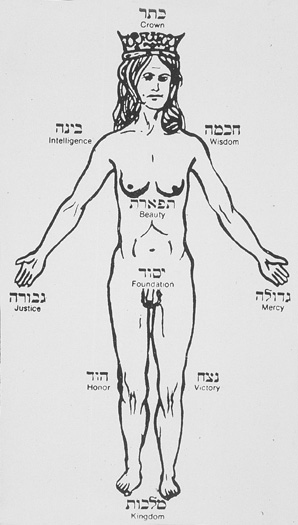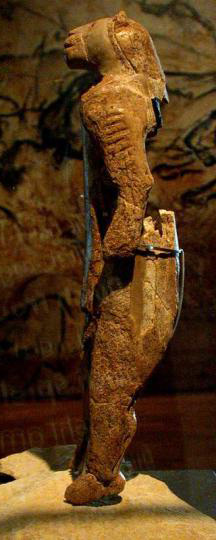Separation of the Sexes



After the separation of the sexes, the originally androgynous or hermaphroditic, bisexual, male-female (Hebrew: זָכָ֥ר וּנְקֵבָ֖ה zâkâr û -neqevâh) human being could only develop in a one-sided form as a male (Hebrew: אִישׁ isch "man, husband") or female (Hebrew: אִשָּׁה ischah "woman, wife"; pl. נָשִׁים "naschim"); man became a single-sex being.
Only the two lowest members of man, the etheric body and the physical body, are affected by the separation of the sexes, but each embodies opposite sexes. If the physical body is male, the etheric body is female and vice versa. In the course of the repeated earth lives of the human being, the sex usually changes with each incarnation, although this rule is often broken. However, a maximum of seven earth lives with the same gender follow each other.
Biological background
Whereas in asexual reproduction the offspring is genetically largely identical and thus a kind of biological immortality is ensured, in sexual reproduction the interaction of two partners of the same species but of different gender types, through the associated exchange of genomes, leads to a rapidly progressing differentiation, through which the individual being with its unique genetic particularity is, however, also necessarily subject to biological death. Through the necessity of mate choice, among other things, the development of the senses was decisively promoted and an abundance of completely new behavioural patterns and a stronger social bond could emerge.
Group Souls - Lion Men and Bull Men
Until the middle of the Lemurian period, reproduction was asexual through a kind of self-fertilisation. In the image of Isis being fertilised by the sunbeam of Osiris, the Egyptian mysteries pointed to this asexual reproductive power of the moon.
The four sphinx animals correspond to the four group souls of Lemurian and Atlantean man. The lion race had a male etheric body which had sufficient power to fertilise the physical body itself without external stimulation. It was a direct fertilisation from the spiritual, without the assistance of another being. The Taurus race, on the other hand, had a female etheric body and gradually lost the ability to reproduce on its own, but was gradually able to fertilise the Leo people. After the absorption of the I, the female sex developed from the lion race and the male sex from the bull race (Lit.:GA 107, p. 74ff).
The soul is male and female at the same time. As long as the bodies were still soft and malleable, they could completely follow the impulses of the soul. As the hardening of the body progressed, this was no longer possible to the full extent. This led to the separation of the sexes, with the male body being shaped more by the impulses of the will and the female body more by the faculty of imagination.
„The times to which we are now looking back lie somewhat before the middle of the epoch which has been called the Lemurian in the preceding sections. The human body then still consisted of soft, malleable materials. The other formations of the earth were also still soft and plastic. In contrast to its later solidification, the earth was still in a swelling, more fluid state. As the human soul then embodied itself in matter, it was able to adapt itself to this matter to a much greater degree than later. For the soul's assumption of a male or female body is due to the fact that the development of the outer earthly nature imposes one or the other upon it. As long as the substances were not yet solidified, the soul could force these substances under its own laws. It made the body into an imprint of its own being. But when the substance had become dense, the soul had to submit to the laws which were imposed on this substance by the outer earthly nature. As long as the soul could still rule over the material, it shaped its body neither male nor female, but gave it characteristics that were both at the same time. For the soul is male and female at the same time. It carries these two natures within itself. Its male element is related to what is called will, its female to what is called imagination. - The outer formation of the earth has led to the body taking on a one-sided formation. The male body has taken on a form which is determined by the element of will, the female body, on the other hand, bears more the imprint of the imagination. Thus it comes about that the two-sexed, male-female soul dwells in a single-sexed, male or female body. In the course of its development the body had taken on a form determined by the outer earthly forces, so that it was no longer possible for the soul to pour all its inner strength into this body. It had to keep some of its strength within itself and could only allow a part of it to flow into the body.
If we follow the Akasha Chronicle, we see the following. In an ancient time human forms appear before us, soft, pictorial, quite different from the later ones. They still carry the male and female nature equally within them. In the course of time the substances become denser; the human body appears in two forms, one of which becomes similar to the later male, the other to the later female formation. When this difference had not yet appeared, each man could give birth to another. Fertilisation was not an external process, but something that took place inside the human body itself. When the body became male or female, it lost this possibility of self-fertilisation. It had to co-operate with another body in order to bring forth a new human being.“ (Lit.:GA 11, p. 74ff)
Male and female wisdom
„Now let us understand how this came about. It came about in such a way that first of all, before there was a male and female sex, there was a bisexuality in the one individual. We must now ask: What was the fertilised and what was the fertilising in the one individual? In ancient Greek mythology, Zeus is depicted with powerful female breasts. This expresses a truth which was known in the ancient Mysteries and which the documents also teach us, that the sex - if I may call it that - which immediately preceded ours, did not outwardly-physically resemble the male sex, but the female sex. So that before the outer separation we have both sexes in one individual, which outwardly - in physical expression and in the whole feeling and being - was female. At the origin of the human race, therefore, we have to do with a dual-sex individual inclined towards the female side. The male sex only emerged later. Now we must be clear that in this individual, which has both sexes within itself, there was also a fertilising, a male seed. The woman had the man within herself. If we make it clear to ourselves that the woman had the man within her, then we can also imagine, in our ordinary scientific terms, that reproduction was assured. Let us note that this happened at that time through the woman.
Now the time came when things were to diverge. What was the character of that which fertilised the female nature on the physical plane? That which acted upon the feminine as seed was the masculine; and that was the spiritual, the wisdom. The female gave the material, the spirit gave the form. Formation on the physical plane is realised wisdom. Wisdom worked in the woman. Now the two differentiated, in that the two things which had formerly worked together appeared as two separate poles. What had formerly been crowded into a single organ of the human being separated, and thus a duality arose in the formation of the human being. This duality arose in such a way that, first of all, in the one individual, fertility, the possibility of the female egg reproducing, ceased. The female egg lost the possibility of being fertilised from its own body. So we have to do with a female that has become infertile and a spiritual that stands above it. Through the splitting off of the physical organs, the separation of the two sexes took place, and the possibility of fertilisation is now given by the other sex. Two individuals come into being, one with physical femininity and the other with physical masculinity: wisdom has a feminine character in the man and a masculine character in the woman.“ (Lit.:GA 93, p. 217)
Literature
- Rudolf Steiner: Aus der Akasha-Chronik, GA 11 (1904 - 1908), Kapitel Die Trennung in Geschlechter English: rsarchive.org German: pdf pdf(2) html mobi epub archive.org
- Rudolf Steiner: Die Tempellegende und die Goldene Legende , GA 93 (1991), ISBN 3-7274-0930-4 English: rsarchive.org German: pdf pdf(2) html mobi epub archive.org
- Rudolf Steiner: Geisteswissenschaftliche Menschenkunde, GA 107 (1988), Zehnter Vortrag, Berlin, 8. Dezember 1908 English: rsarchive.org German: pdf pdf(2) html mobi epub archive.org
- Rudolf Steiner: Das Ereignis der Christus-Erscheinung in der ätherischen Welt, GA 118 (1984), ISBN 3-7274-1180-5 English: rsarchive.org German: pdf pdf(2) html mobi epub archive.org
- Rudolf Steiner: Geistige Zusammenhänge in der Gestaltung des menschlichen Organismus, GA 218 (1992), ISBN 3-7274-2180-0 English: rsarchive.org German: pdf pdf(2) html mobi epub archive.org
 |
References to the work of Rudolf Steiner follow Rudolf Steiner's Collected Works (CW or GA), Rudolf Steiner Verlag, Dornach/Switzerland, unless otherwise stated.
Email: verlag@steinerverlag.com URL: www.steinerverlag.com. Index to the Complete Works of Rudolf Steiner - Aelzina Books A complete list by Volume Number and a full list of known English translations you may also find at Rudolf Steiner's Collected Works Rudolf Steiner Archive - The largest online collection of Rudolf Steiner's books, lectures and articles in English. Rudolf Steiner Audio - Recorded and Read by Dale Brunsvold steinerbooks.org - Anthroposophic Press Inc. (USA) Rudolf Steiner Handbook - Christian Karl's proven standard work for orientation in Rudolf Steiner's Collected Works for free download as PDF. |
